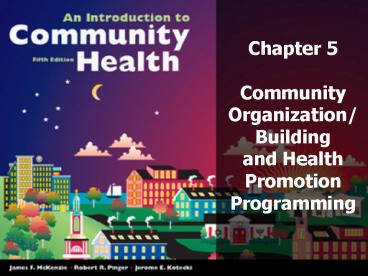Community OrganizationBuilding and Health Promotion Programming - PowerPoint PPT Presentation
1 / 23
Title:
Community OrganizationBuilding and Health Promotion Programming
Description:
State and summarize the steps involved in creating a health promotion program. ... 5. A 'holistic approach' can deal successfully with problems with which a ' ... – PowerPoint PPT presentation
Number of Views:107
Avg rating:3.0/5.0
Title: Community OrganizationBuilding and Health Promotion Programming
1
Chapter 5 Community Organization/Building
and Health Promotion Programming
2
Chapter Objectives
- Define community organizing, community capacity,
community participation, and empowerment of the
community. - Identify the assumptions that underlie the
process of community organization. - Briefly explain the difference between locality
development, social planning, and social action
approaches to community organization. - Explain the difference between needs-based
community organizing models.
3
Chapter Objectives
- List the steps for a generalized model for
community organizing/building. - Explain what is meant by community building.
- Explain the difference between health education
and health promotion. - State and summarize the steps involved in
creating a health promotion program. - Define the term needs assessment.
4
Chapter Objectives
- Briefly explain the six steps used in assessing
needs. - Explain the difference between goals and
objectives. - List the different type of intervention
strategies. - Explain the purposes of pilot testing in program
development. - State the difference between formative and
summative evaluation.
5
Community Organizing
- Community health problems can be small, only
involving a few people, or can be very large,
encompassing everyone in the community. - Community organizing was a term coined by
American social workers in the 1880s to describe
their coordination efforts for newly arrived
immigrants and the poor.
6
Definition
- Community organizing
- A process through which communities are helped
to identify common problems or goals, mobilize
resources, and in other ways develop and
implement strategies for reaching their goals
they have collectively set.
7
Definitions (continued)
- Community capacity Community characteristics
affecting its ability to identify, mobilize, and
address problems. - Community participation A process of involving
people in the institutions or decisions that
affect their lives. - Empowered community One in which individuals
and organizations apply their skills and
resources in collective efforts to meet their
respective needs.
8
Assumptions of Community Organization
- 1. Communities of people can develop the capacity
to deal with their own problems. - 2. People want to change and can change.
- 3. People should participate in making,
adjusting, or controlling the major changes
taking place in their communities. - 4. Changes in community living that are
self-imposed or self-developed have a meaning and
permanence that imposed changes do not have.
9
Assumptions of Community Organization
- 5. A holistic approach can deal successfully
with problems with which a fragmented approach
cannot cope. - 6. Democracy requires cooperative participation
and action in the affairs of the community, and
people must learn the skills that make this
possible. - 7. Frequently, communities of people need help in
organizing to deal with their needs, just as many
individuals require help with individual
problems.
10
Community Organizing Methods
- Locality development
- A broad self-help method in which local citizens
develop new skills and become more
self-sufficient - Social planning
- Utilizes skilled volunteers in the community in a
technical process of problem solving - Social action
- A technique that involves the redistribution of
power and resources to disadvantaged segments of
the population
11
Steps in Community Organizing
- Recognizing the issue
- Gaining entry into the community
- Organizing the people
- Assessing the community
- Determining the priorities and setting goals
- Arriving at a solution and selecting intervention
strategies - Implementing the plan
- Evaluating the outcomes of the plan of action
- Maintaining the outcomes in the community
- Looping back
12
The Final Four Steps
Implementing
Looping back
Evaluating
Maintaining
13
Creating a Health Promotion Program
Assessing needs
Identifying the problem
Setting goals objectives
Developing an intervention
Implementing the intervention
Evaluating the results
A Generalized Model for Program Planning
14
Creating a Health Promotion/ Disease Prevention
Program Overview
- Assessing the needs
- Identifying the problem(s)
- Setting goals and objectives
- Developing an intervention
- Implementing the intervention
- Evaluating the results
15
Assessing the Needs
Determining the purpose scope
Gathering data
Analyzing the data
Identifying factors linked to the health problem
Identifying the program focus
Validating the prioritized need
16
Questions to Be Asked After the Needs Assessment
- Who is the priority population?
- What are the needs of the priority population?
- Which subgroups within the priority population
have the greatest need? - Where are the subgroups located geographically?
- What is currently being done to resolve
identified needs? - How well have the identified needs been addressed
in the past?
17
Creating a Health Promotion/ Disease Prevention
Program Overview
- Assessing the needs
- Setting goals and objectives
- A goal is a future event toward which an endeavor
is directed. - Objectives are steps taken in pursuit of a goal.
- Developing an intervention
- Designing activities that meet your objectives
- Implementing the intervention
- Putting into practice
- Evaluating the results
- Formative evaluation
- Summative evaluation
18
Hierarchy of Program Objectives
- Process/administration objectives
- Learning objectives
- Action/behavioral objectives
- Environmental objectives
- Program objectives
19
Evaluating the results
Planning the evaluation
20
Evaluating the results
Planning the evaluation
Collecting the data
21
Evaluating the results
Planning the evaluation
Collecting the data
Analyzing the data
22
Evaluating the results
Planning the evaluation
Collecting the data
Analyzing the data
Reporting results
23
Evaluating the results
Planning the evaluation
Collecting the data
Analyzing the data
Reporting results
Applying the results































